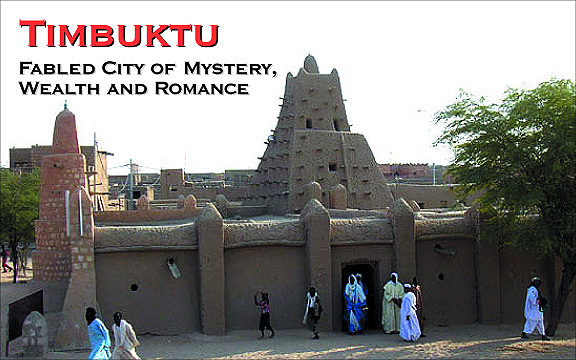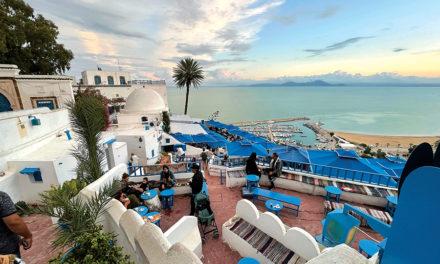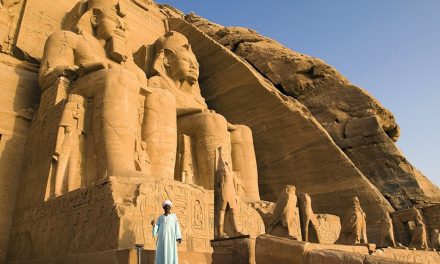Timbuktu
Fabled City of Mystery and Romance
Published in the Summer 2008 Issue of Canadian World Traveller
By Habeeb Salloum (habeeb.salloum@sympatico.ca)
Photos: Courtesy of Ministère de l’Artisanat et du Tourisme de la République du Mali (www.tourisme.gov.ml)
When I told my friend that I had travelled to over a hundred countries in a dozen years, he asked me, “Have you been to Timbuktu?”
Disappointingly, I had to respond in the negative. Even though my voyages had been many, I had not yet visited that fabulously historic African city of enigma, opulence and romance.
Long associated with mysterious beauty, learning and wealth, this town once forbidden to Europeans, was for centuries a subject of unusual lore and mystery.
For hundreds of years, tales of this fabled golden city made it the Mecca of early European explorers. Those intrepid adventurers had to brave mile after mile of burning desert sand, inhabited by hostile tribes, to reach the Ultima Thule (or El Dorado) of desert travellers.
Even today, the name Timbuktu (also spelled Tombouctou) is still synonymous with travelling to the ends of the earth.
Edge of the Sahara
Situated in Mali at the most northerly bend of the Niger River, near the southern edge of the Sahara, this renowned, land-locked, northwestern African city is also located at the end of ancient trans-Saharan caravan routes that once crisscrossed the immense, unforgiving desert.
The wealth generated by the caravan merchants gave Timbuktu the glamour that fascinated medieval Europe. Yet, due to its geographical position, with no natural protection against invaders, it never became a capital of an African state.
Founded in the 11th century as a seasonal camp for Tuareg nomads, Timbuktu gets its name, according to one of many legends, from the Berber “tim” (place of) and Arabic “bouctou” (a sand dune).
In the 14th century, under the famous Emperor Mansa Musa, it became an important centre of the Mali Empire for Muslim commerce, scholars and the African gold trade.
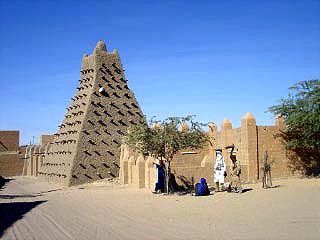 New Architectural Style
New Architectural Style
After making a pilgrimage to Mecca, the Emperor returned to Timbuktu, with an Andalusian Muslim architect, Abu-Ishaq Ibrahim-es-Saheli, who introduced Mali to a new style of architecture, especially in the building of its mosques and palaces.
In the ensuing centuries, his works changed the design of buildings throughout West Africa. The burnt bricks, flat roofs and pyramidal minarets one sees in West Africa today, are a result of his influence.
The Djingareyber Mosque in Timbuktu, which is the oldest surviving house of worship in West Africa, dates back to his time.
A Just People
In the mid 14th century, some 20 years after Mansa Musa’s death, the great Moroccan traveller Ibn Battutah wrote after visiting Mali, that there was complete security in the country and its people were seldom unjust, having a greater abhorrence of injustice than any other people.
After over a hundred years of being a part of the Empire of Mali, Timbuktu experienced a period of upheaval until 1468, when it was conquered by the armies of the pseudo-Muslim Sonni Ali, founder of the Songhay Empire. After his death, one of his generals, Muhammad Touré usurped power in 1493.
Known as Askia Muhammad or ‘Askia the Great’, he ruled until 1529. Unlike Sonni Ali, he showed his commitment to Islam after taking power by setting out on a pilgrimage to Mecca with an escort of 500 cavalry and 1000 infantry and 300,000 pieces of gold – comparable, but on a smaller scale, to Mansa Musa’s pilgrimage a century and a half before.
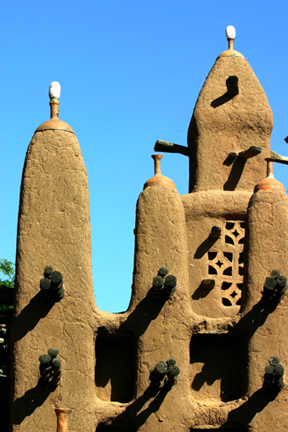 Askia’s Legacy
Askia’s Legacy
Some Muslim learned men tended to exaggerate when writing about Askia Muhammad. One scholar compared him to a brilliant light shining after a great darkness and a saviour who drew the servants of God from idolatry and saved the country from ruin. No doubt, he was comparing him to his predecessor, Sonni Ali who, being Muslim only in name, persecuted Muslim scholars.
At its peak in the 16th century, Timbuktu was a dynamic city with a population of some 200,000 and was regarded as the economic capital of the western Sudan. Some historians dispute the number of inhabitants, claiming the city only had a population of 100,000.
In that era, this African metropolis had no equal in the cities of the world. Peace, order and security reigned, commerce boomed and in Timbuktu’s 150 Qur`ranic schools, scholarly activities flourished. The city became a great educational metropolis, shining brightly in the medieval world.
World Centre of Learning
For many decades, the University of Sankoré in Timbuktu was the intellectual centre of Africa – famous for the teaching of Islamic law, literature and medicine.
With an enrolment of some 2,500 students, it was once one of the largest schools of learning in the world, attracting scholars from all over the Muslim world who either came to teach or to learn.
The books written by many of those revered West African writers and teachers are still in use today. Scholars of that period were respected for their generosity, strength of character and discretion.
Moroccan Occupation
The Moroccan army put an end to the Songhay Empire. In 1591, it occupied and sacked the city and in the subsequent centuries, Timbuktu went into decline.
However, due to its remoteness and its close association with the gold trade, it was still intriguing to most Europeans.
Some historians indicate that between 1588 and 1853, 43 Europeans tried to reach the city, but only five were successful: Adams, Barth, Caillié, Laing and Park.
The tales they brought back made Timbuktu, in Westerners’ eyes, a mysterious and fabulously rich city, further away than ‘the back of beyond’.
After nearly 400 years of decline, Timbuktu is now a lacklustre town of low flat-roofed mud brick homes, covered with a stucco of grey mud, with an estimated population of 30,000 to 40,000, depending on the seasonal influx of nomads.
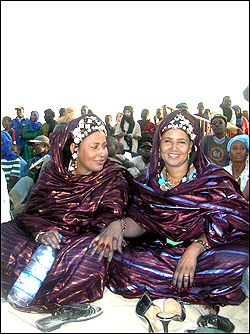 To Timbuktu and Back
To Timbuktu and Back
Seemingly lost in the middle of the desert, Timbuktu is gradually being overwhelmed by encroaching desert sands.
Today, its mystery and glory are mostly found in its past history. Nevertheless, this UNESCO World Heritage Site, still invokes the image of remoteness and mystic glory.
“Have you been to Timbuktu?” If not, you still have time to take a fascinating trip to what some still call the very end of the Earth!
For More About Timbuktu:
Mali Tourism
Website: www.tourisme.gov.ml (In French)
Mali Embassy
50 Avenue Goulburn
Ottawa, ON K1N 8C8
Tel : 613-232-1501
Email: ambassadedumali@rogers.com
Website: www.ambamalicanada.org (Bilingual)

